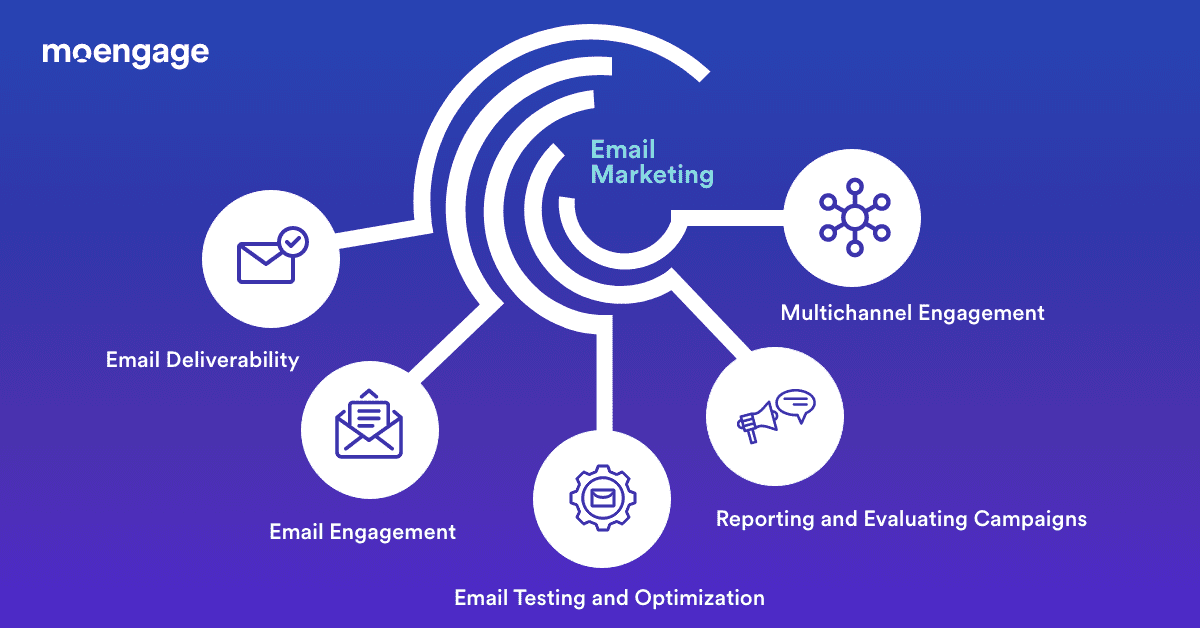The Modern Marketer’s Quick Guide to Email Marketing
Read this in-depth guide to learn:
✓ Best practices for email deliverability and engagement
✓ How to report and evaluate email campaigns
✓ Multi-channel engagement as part of your customer experience strategy



What's Inside the Email Marketing Guide
With 90% of organizations using it to make the sale, email has emerged as a key piece of the modern marketer’s toolkit. Hence, adopting best practices for deliverability, optimizing emails for maximum engagement, and constantly evaluating important metrics becomes crucial.
Best Practices for Email Deliverability
Emails from a Dedicated IP
Establish a dedicated address for marketing emails to improve IP reputation.
Warm-up Your IP Address
Send a consistent trickle of emails in the initial days, slowly increasing volume with each cycle.
Avoid Spam Words
Using spam triggers such as ‘cheap,’ ‘free,’ ‘lowest price’, ‘buy now’ or excessive use of capital letters can land the mail in spam.
List Management
Regularly update your subscriber list to include only active users. Remove any hard bounces and users who have complained.
User Engagement
Email service providers also track how their customers interact with everything they receive and move emails to spam accordingly.
Sender Authentication
ISPs run a series of authentication tests to ensure that email senders are who they say they are.
Trusted By Global Brands





Frequently Asked Questions
What is email marketing?
Email marketing usually involves sending a commercial message such as new products, discounts, and other services broadcasted using email. Email marketing can help you build that long-term relationship with your customers while also driving traffic to your blog, social media, or to your physical store.
What is the role of email marketing?
Email marketing is one of the most widely used channels by marketers to connect with their audiences. If done right, an email campaign offers a cost-effective way to reach a large audience and convert new interest into sales.
Is email marketing still relevant?
It’s no wonder email has emerged as a key piece of the modern marketer’s toolkit — with nearly 90% of organizations using it to make the sale. If done right email marketing is gives upto 44X ROI.
How to get started with email marketing?
You can get started with email marketing by crafting your goals and KPIs, then building your email list, set best practices for brand communications, planning your content and campaigns such as newsletter, promotion, announcement etc to your audience.
How to avoid spam filters?
Every marketer aims to avoid the ‘spam’ folders so their emails are visible and opened by their intended audience. When spam filters sift through your email, they check for use of spam trigger words. Even excessive use of capital letters, poor spelling or grammar issues can land the mail in spam.
How do you ensure email deliverability?
Unlike delivery, deliverability tells you if your emails are actually reaching the recipients’ primary inbox. That means establishing best practices for deliverability, optimizing emails for maximum engagement, and constantly evaluating important metrics.
What affects email deliverability?
There are various factors that affect email deliverability such as: sending bulk email bursts from a new IP, use of spam trigger words like ‘cheap,’ ‘free,’ ‘lowest price’ or ‘buy now’ to name a few.
How do I keep my email subscribers engaged?
Emails that offer genuine value to the user receive maximum open rates and engagement. Key factors to look into – segmentation, triggered timing, contextual content and personalization.
How do I optimize my email campaigns?
Clean your email lists regularly to maintain good domain and IP reputations. Remove or decrease mailing frequency for disinterested users. Identify hard bounces, spam traps, and blacklists early on. Keep your email list populated with only those users that want to receive your emails.
What makes a good email campaign?
Engaging users at the right time with the most relevant content makes for a personal experience that goes beyond their expectations, fostering goodwill and investment in the brand.
How do you calculate ROI on email campaigns?
Beyond open rates and click rates, there are three types of metrics that should be tracked to measure email engagement are: email deliverability, click analysis, and conversion rate.

